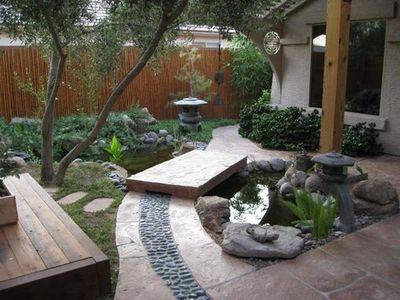Having a Zen garden in your own front yard is a great way to reduce stress and improve your focus and sense of well-being.
Developed by Buddhist monks in ancient Japan (with some Chinese influence), a Zen garden is a Japanese stone garden comprising mostly of gravel, stones and boulders. It frequently has smooth curved lines, a wonderful balance of simple elements and is completely devoid of plants.
Zen gardens are easy to maintain, especially when they mainly use gravel. Their design is also visually appealing. Zen gardens provide tranquility which helps you de-stress.
These gardens, found all over in Japan, have served the Zen monks for centuries as part of their meditation. The calm and serene ambience they offer can help clear the mind of worries and focus on the present.
MINIMALISTIC GARDEN
Zen gardens can be considered minimalistic as their components symbolise aspects of nature.
The symbolic use of raked gravel to represent water leads to such gardens being characterised as “dry landscapes”, while heavy reliance on rocks make some refer to them as “Japanese rock gardens”.
Any short trees or shrubs that are included in the design must be pruned meticulously. Some of the popular plants used in Zen gardens are bamboo, bonsai, conifers and ferns. They are planted for year-round interest.
Bonsai is perhaps one of the most popular as it represents a fusion of strong ancient beliefs with Eastern philosophies of the harmony between man, the soul and nature. These miniature trees are grown in ceramic containers and then pruned to give them classic shapes.
GETTING STARTED
When making a Zen garden, the aim should be to create a mood of calm and tranquility.
The tools and supplies you will need are gravel (preferably white), rocks (in a variety of sizes and shapes), steel/wooden garden rake, shovel, hoe, measuring tape, landscape fabric, edging stones and gloves.
To get started, select a flat area in your garden and mark out a square or rectangular portion of it. If you plan to include plants in your Zen garden, make sure the area has sufficient sunlight.
Clear the selected space completely from plants, weeds and stones.
With a shovel, remove the top layer (a few inches) of the existing soil.
Using the steel garden rake, rake out uneven spots and tamp down the soil.
Run stone edging along the marked out square or rectangular space to retain the white gravel that you are going to add at the very end.
Dig holes for the rocks you’ll be using to represent mountains and/or islands and for the plants that you are adding into the design. Place the rocks and plants in their holes. Be sure to bury most parts of
the rocks into the ground. This tip-of-the-iceberg placement will make the rocks more natural.
Lay landscape fabric over the soil, making cuts to accommodate the rocks and plants.
Apply a few inches of the white gravel. Spread it with the hoe to distribute it.
Add a little bench if you like at the side or in the middle of the garden to enjoy your creation.
.jpeg)
_PH_Banner_(Desktop)(1200x180px).png)








.jpg)
.jpg)

.jpeg)

